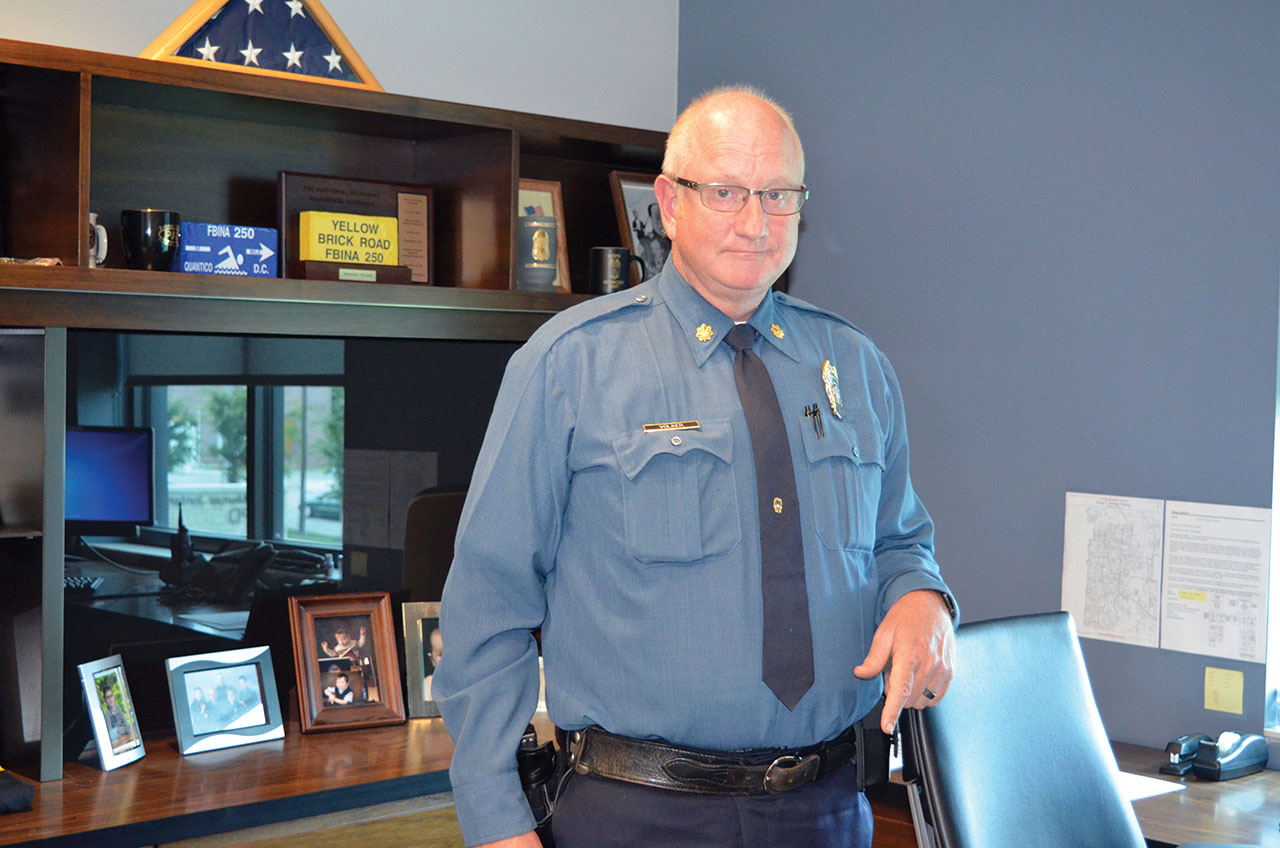KCPD adopts risk-based policing techniques in crime-prevention strategies
Elizabeth Orosco
Northeast News
In a crime prevention effort, the Kansas City Police Department (KCPD) is implementing risk-based policing, the latest advancement in police innovation that aims to police places, not people.
KCPD Sergeant Jonas Baughman gave a presentation on Risk Terrain Modeling (RTM) to community members at the Northeast Kansas City Chamber of Commerce to discuss how RTM will be implemented in the community.
RTM assesses environmental factors that contribute to crime. It diagnoses how features of the landscape overlap to create unique behavior settings for crime.
KCPD can then work alongside other agencies to address each individual factor that may contribute to crime.
Based on research by Dr. Leslie Kennedy and Dr. Joel Caplan at Rutgers University, RTM has been tested in over 35 states in the U.S. and in over 45 countries across six continents.
While no two cities are exactly alike, KCPD Major Greg Volker said he will work to adapt this strategy to fit individual neighborhoods.
“We want to make sure we work with Kansas City neighborhoods,” he said. “We are taking an idea and fitting it to this city and matching it to the community and to the neighborhoods.”
As a prevention piece, it informs decisions on how these high-risk factors contribute to criminal behavior, how these environments can be assessed and what actions can be taken to prevent or reduce worse possible outcomes.
RTM offers data-driven statistics to objectively identify vulnerable places.
Some high-risk factors that have been identified include gas stations/convenience stores, vacant buildings, bus stops, laundromats and homes with property violations.
A Risk Terrain Map is created that layers these individual high-risk environmental factors on top of one another to hone in on high-risk areas where multiple high-risk factors overlap.
This is different from locating crime “hot spots.” Hot spots map out areas where crime has already occurred and identifies areas with a large number of criminal activity.
RTM identifies areas where crime is likely to occur based on the presence of multiple high-risk environmental factors.
Once these areas are highlighted as high-risk, KCPD can collaborate with other agencies to determine what can be done to eliminate the portions of the environment that enable crime.
Is a bus stop poorly lit? KCPD can work with the Kansas City Area Transportation Authority (KCATA) to suggest offering better lighting in this area.
Are there nearby vacant properties? KCPD can notify Neighborhood Preservation, a division of the Neighborhoods and Housing Services Department, to suggest prioritizing boarding up or demolishing the vacant properties.
Essentially, eliminating the environmental high-risk factors at a specific area through partnerships with various agencies can help reduce illegal activity and violent crime that occurs there.
According to KCPD, 35 percent of the 2019 homicides in Kansas City have been within 466 feet (approximately one street block) of the top 1 percent of risky places.
KCPD has identified Independence Avenue and Benton as a high-risk area, and it is where they will be concentrating efforts.
At this intersection is a convenience store and a bus stop on the north and south side of Independence Avenue.
To prevent the “displacing” of criminal activity, they will expand this area to Anderson on the north, 12th Street on the south, Jackson on the east and Wabash on the west.
“If my officers stop someone at Independence and Benton and they take their activity north, then they go into Scarritt,” Volker said.
They will be looking to implement risk-based policing in this area, targeting places, not people.
An example of how this would be implemented practically would be an officer conducting a business check at a convenience store in this outlined area that may be near a bus stop, vacant buildings, or other high-risk environmental factors.
The officer would speak with the owner of the store and discuss potential crime issues and check for a valid liquor license or the need for potential “no trespassing” signs.
The officer could then make notifications to surrounding agencies such as Regulated Industries to address the need for a valid license.
The result would be a decrease in environmental high-risk factors that would contribute to criminal activity.
Police officers would have a clear idea of what areas to focus on during patrol and what can be done when they arrive.
This analysis takes the focus off people and puts it on places that persistently enable illegal behaviors.
Baughman urges residents to contact their Community Interaction Officers (CIOs) to give detailed information on areas in their neighborhoods that attract criminal activity.
“We can patrol that area as much as we can, but you live there day-to-day,” Baughman said.
Major Volker said this RTM model will allow various agencies to work together.
“It’s not just about us, not just about law enforcement, it’s about the community,” Volker said. “It’s about listening to the community and opening yourself up to say, ‘how can we make it better?’”
Baughman said with the risk-based policing model, officers will be working to identify certain tasks while on patrol and will not take away from any current duties or patrol areas.
“Officers will start using the RTM maps, namely looking at high-risk areas from a perspective of ‘what needs to change here to make things better?’ as opposed to simply increasing stops or arrests,” Baughman said.
This provides officers not only with a location of where to patrol, but answers the question of why they need to be there.
Once in a high-risk area, officers can try and find a way to address a given risk factor. This RTM model will not change or create a new protocol for crime report writing, but Baughman said officers will be able to add a simple note in the CAD system to indicate what was done in a particular high-risk area and if any follow-up is needed.
One example Baughman gave was an officer visiting a liquor store in a high-risk area, speaking with the employees and patrons, and observing no liquor license during their visit. The officer can make a note that states “Observed no liquor license; called Regulated Industries for follow-up regarding lack of license.” No report is necessary and the officer can continue patrolling.
Baughman said they are in the beginning stages of implementing the RTM model in the aforementioned outlined area and have met with various agencies including Kansas City Planning and Development, Public Works, Public Health, KCATA, and the 311 Call Center.
This presentation on the risk-based policing model comes on the heels of a recent announcement to increase the CrimeStoppers TIPS Hotline cash reward to $25,000 in a further effort to tackle crime in Kansas City.
For more information regarding the Risk Terrain Model or risk-based policing model, please contact your area CIO, which can be found on the homepage at www.kcpd.org.
The CrimeStoppers TIPS Hotline is (816) 474-TIPS or (816) 474-8477.




















